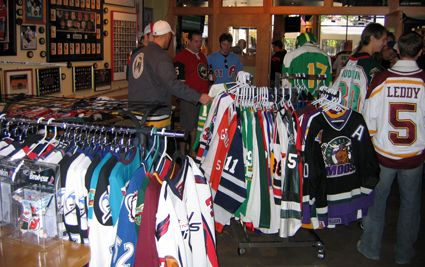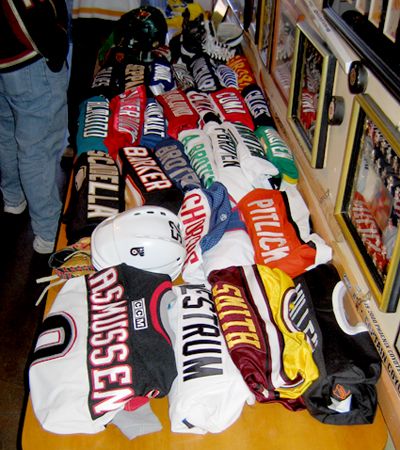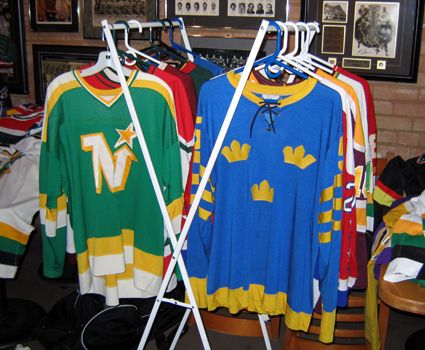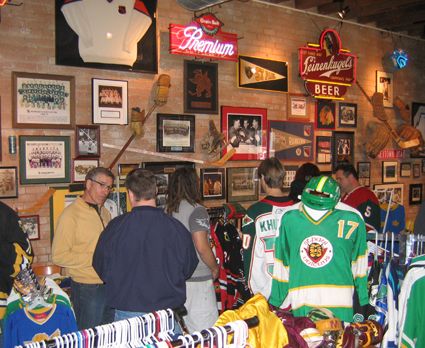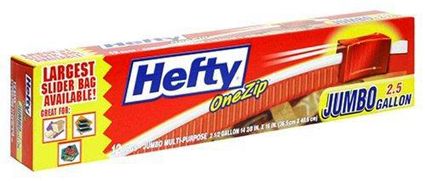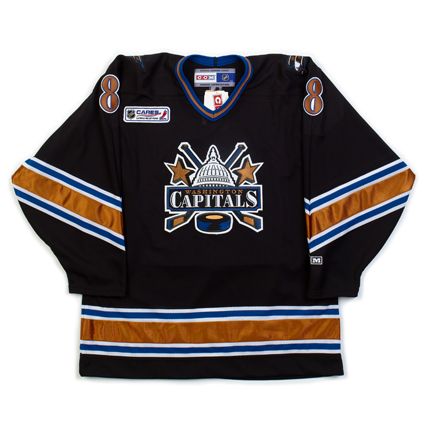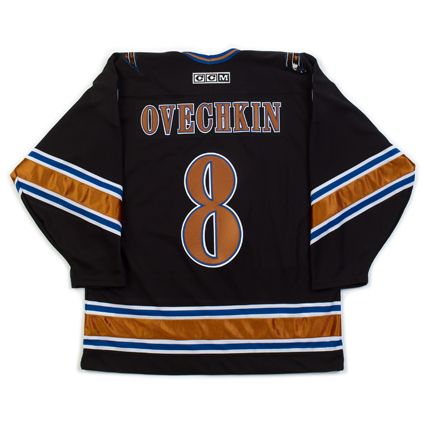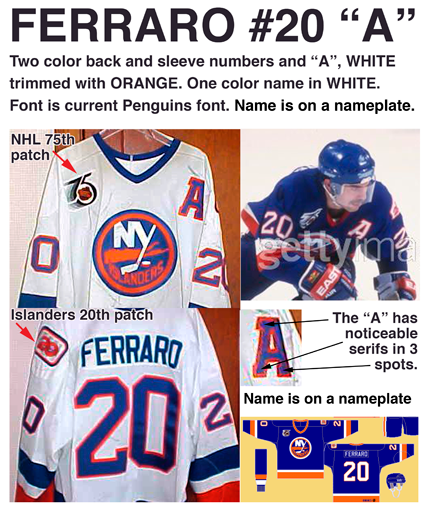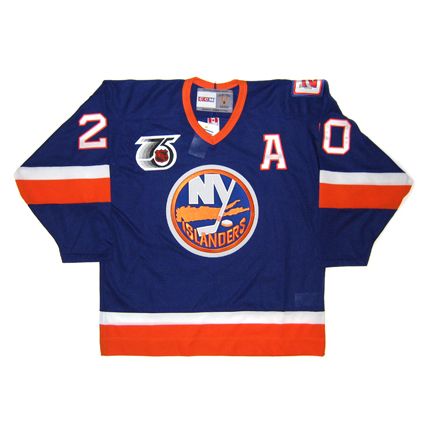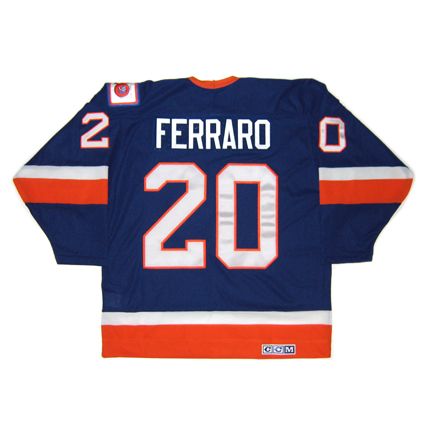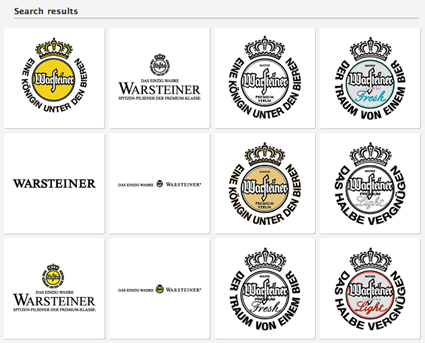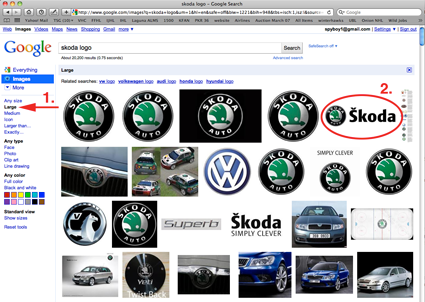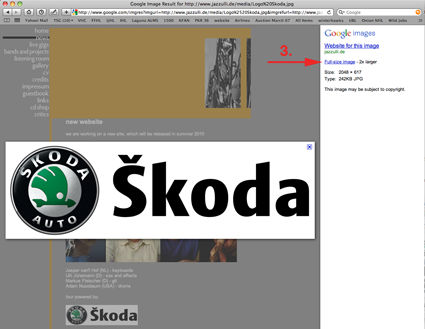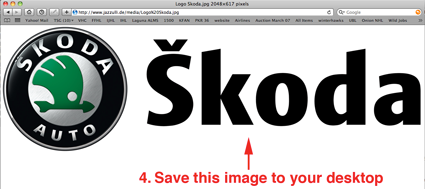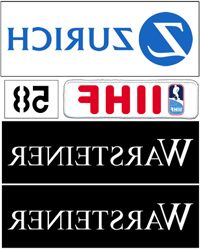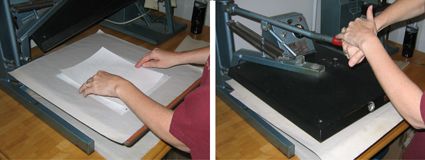Friday, September 23, 2011
The 10th Annual Minnesota Hockey Collectors Expo
To expand on yesterday's Hockey Jersey Training Camp drill about the jersey collecting community, Sunday, October 2nd is one of the highlights of the collecting calendar. Anyone in the Twin Cities of Minneapolis and St. Paul should stop by Tom Reid's Hockey City Pub near the Xcel Energy Center for the 10th Annual Minnesota Hockey Collectors Expo from 11 AM to 6 PM.
It's the largest gathering of game worn jerseys in Minnesota each year and you can count on seeing some amazing and varied collections in a great hockey environment. This event is free and features collectors bringing favorites from their personal collection for some good old show and tell, with an emphasis on jerseys related to the Minnesota Wild, Minnesota North Stars and Minnesota Gophers, as well as many other interesting jerseys from throughout the hockey world. It's great opportunity to see some great game worn jerseys up close, meet some new people and perhaps add a new jersey to your collection.
Last year former Minnesota North Stars Brad Maxwell,Tom Younghans and Gordie Roberts were in attendance, as was Minnesota Wild team historian Roger Godin.
To further entice you to attend, here are some photos from last year's event.
Above is the impressive Ben Clymer collection on the left and Kyle Oen's Minnesota themed collection on the right. Collecting one player, such as Clymer can be a challenge when they make multiple stops in the NHL and AHL, but that challenge increases exponentially when a player extends his career by playing in Europe, so this collection was all the more impressive with the addition of game worn jerseys from the German DEL.
Kyle brought a sampling of his game worn Minnesota high school jersey collection that rivals the one on display at the Xcel Energy Center, as well as other Minnesota based teams. Note the game worn University of Minnesota Nick Leddy jersey being worn in this photo. Golden Gophers game worn jerseys are very, very difficult to come acquire, especially one so recent and of a player of such potential as Leddy.
Above is John Lindberg's take on a Minnesota theme. Where Kyle collects teams from Minnesota, John is more about former Gophers NHL jerseys as well as Minnesota Wild prospects jerseys worn before they reach the NHL.
Can't make it to the Hockey Hall of Fame in Toronto? Then having the opportunity to see Jon Bakke's amazing collection of vintage jerseys with an international flavor can save you the trip. That's not just an old Sweden jersey either, it's Borje Salming's jersey! John can easily be spotted at Minnesota Wild games wearing his rotating collection of gamers, as he doesn't just hang them in a closet, he wears his regularly to Wild games.
Here are two more collections, which come at the hobby from different directions. Chris Groth (hanging on the left) just collects what catches his eye, although with a Minnesota influence, such as Mikko Koivu's game worn retro Finland jersey worn for one game of the 2008 World Championship, but his Alexander Ovechkin game worn jersey was certainly an Expo highlight.
The collection folded on the the table on the right was a very interesting collection of vintage NHL jerseys, mainly the 1980's and 1990's, from our favorite period of NHL jerseys and were terrific to look at and talk about.
Here was our contribution to the proceedings, closer to the camera were our jerseys worn in the movie "Miracle" and our game worn international jerseys from places such as East Germany, Holland, Iceland, Japan, Poland and even Spain as well as the more traditional countries like Canada, the Czech Republic and Russia. We also brought our Minnesota Twins baseball gamers on the far side of the rack.
The walls of Tom Reid's are just dripping with hockey memorabilia and create the perfect environment to hold such an event.
Finally, the event organizer Dave Frechette, without whom the Expo would not exist. Dave's collection focuses primarily on Minnesota Wild players jerseys, primarily before they joined the Wild, or at least non-Wild jerseys. Examples in his collection are Wild prospects college and junior team jerseys, European born players European club teams, Wild coaches sweaters from their NHL playing days, Wild players previous NHL team's jerseys and Wild players jerseys worn when they played for their national teams, such as Mikko Koivu's Team Finland jerseys.
How he is consistently able to track down jerseys from such a wide variety of sources is one of the more impressive things to take in at the Expo. He also has an appreciation of hockey history, as evidenced by the rare and wonderful Minnesota Fighting Saints WHA jersey seen here as well as his North Stars game worn jersey he is wearing.
We certainly hope those of you in the area will take the time to attend this can't miss event!
Labels:
Minnesota Hockey Collectors Expo
Thursday, September 22, 2011
Hockey Jersey Training Camp - Day 9 - The Collecting Community
Day 9 of Hockey Jersey Training Camp moves onto our next "drill" on The Collecting Community.
You've located your jersey and perhaps a patch to put on it, decided whose name and number to add to it, sent it in for customizing and your newly lettered jersey has (finally) arrived in the mail.
Now what? Obviously you can wear it to a game or just around town, making certain to NOT tuck it in, or you can show it off to your friend's friend who responds by saying he can get "any jersey you want" for $40 (which you know will be a Chinese knockoff) and has zero appreciation for your authentic jersey.
Or, you can show it off to like minds online who can relate to the scarcity of your new sweater, the accuracy of the customization and the attention to detail that your patch brings to your jersey.
Two such places are the forums at JerseyCentral.org, for fans of jerseys of all sports, and IceJerseys.com, who host a hockey jersey only forum for jersey collectors.
Here you can ask questions about the authenticity of potential purchases, learn the finer points of how to spot fakes yourself, where to locate patches, advice on customizers and player choices for your jerseys, buy new jerseys and sell your old ones once you have established yourself as a member of either community and simply show off your new arrival as well as seeing what unique things others have acquired, which will certainly inspire you to try to duplicate one for yourself from time to time.
While the Ice Jerseys forum is strictly hockey related, Jersey Central has separate forums for Throwbacks, NFL, MLB, NBA, Soccer and College as well as hockey. In addition, both forums each have a very active marketplace section and general discussion section.
The depth of knowledge available is quite remarkable as passionate collectors share their insights and knowledge on all things jersey related.
Once you've joined a forum, it's part of the fun to share your collection with others. Photographing your jerseys is an essential part of that and we have a few tips. We recommend a mid-tone background of either a beige carpet, wood flooring or a roll of seamless paper. A mid-tone background will work for both white and dark colored jerseys and look more consistent from shot to shot.
We do not recommend white or black backgrounds or tile surfaces or fabric surfaces, such as a sheet. White backgrounds won't allow white jerseys to separate very well and will fool the camera into thinking the scene is too bright, resulting in underexposed, grey photos, while black will have the opposite results. Black backgrounds will cause light colored jerseys to be overexposed and black jerseys to disappear into the background. The shine on tile surfaces will cause a glare from the flash which may also result in underexposed images. Those with prominent grout will only serve to distract from the jersey, the same of which can be said for a wrinkled sheet.
Once you have chosen your background, lay your jersey down, fold the arms over and get the jersey as flat as possible to reduce as many wrinkles as you can.
We do recommend the use of an on-camera flash. The light hitting the jersey from directly overhead will reduce the appearance of any wrinkles in the jersey, which would be emphasized by any side lighting, such as that coming from a window on one side of the jersey. A flash also has the added benefit of being the same each time, while reliance on sunlight leaves you subject to both sunny and cloudy days, resulting in inconsistent lighting.
To summarize, pick a background, not too light or not too dark, with as little pattern to it as possible and shoot from straight overhead with a flash.
You will need to host your own photos on the internet to be able to post them to any forum. There are many free photo hosting sites from which to choose from, Flickr, Photobucket or Webshots.
As for meeting up with other collectors in person, there are two events that we recommend.
The first is the annual MeiGray Game-Worn Jersey Expo in New Jersey where the largest dealer of NHL game worn jerseys brings together collectors and dealers alike in a festival of jerseys unlike any other.
The other event we recommend is the Minnesota Hockey Collectors Expo at Tom Reid's Hockey City Pub in St. Paul, Minnesota. The 10th annual Expo takes place Sunday, October 2nd from 11 AM to 6 PM. This event is free and features collectors bringing their favorites from their personal collection for some good old show and tell, with an emphasis on jerseys related to the Minnesota Wild, Minnesota North Stars and Minnesota Gophers, as well as many other interesting jerseys from throughout the hockey world. It's great opportunity to see some great game worn jerseys up close, meet some new people and perhaps add a new jersey to your collection.
There are other expos held throughout the country, perhaps one near you. November 12th sees the MeiGray Group Game-Worn Jersey Detroit Expo 45 minutes from Detroit at the Huntington Center in Toledo, Ohio from 10 AM to 4 PM.
The second annual Pittsburgh Hockey Expo is on December 17th, 2011 at the Epiphany Church Hall next to the Consol Energy Center. Announcements and details for this and other collector meetings can be found on the forums at GameWorn.net.
Labels:
Hockey Jersey Training Camp
Wednesday, September 21, 2011
Hockey jersey Training Camp - Day 8 - How to Communicate With Your Customizers
Day 8 of Hockey Jersey Training Camp moves onto our next "drill" on how to communicate with your customizers.
When spending your hard earned money having your rare jersey customized, the last thing you want when you finally get it back is an unwanted surprise, be it the wrong font, the wrong placement for a patch or wrong material for a nameplate. This is a battle we have fought dating back to the first jersey we ever owned.
In order to avoid disappointment, we make a policy of over-communicating he specifics of what we want and expect on our completed jersey.
As we referenced on Day 4 of Hockey Jersey Training Camp, our favorite sources for photos is GettyImages.com's editorial sports section. It does take some experience to learn how to do effective searching on Getty Images, and older pictures are often not labelled very accurately with the correct date or even year, but there's more than enough on file there to help document just about any jersey project you'd like done.
For our sample, let's pick an Alexander Ovechkin Washington Capitals rookie home jersey. Start by searching for the team you are interested in, "Washington Capitals". If you search for just the player, you may exclude some excellent sample photos of the style of jersey you want done. Perhaps there's a photo of #18 Matt Pettinger that documents that style of jersey perfectly. Once you get an overwhelming 1062 pages of results, begin to narrow it down by selecting "search within" and entering the year "2005" in the search box. Don't enter "2005-06", as the photos are tagged with the year they were taken in, not the NHL season they are from. If you don't find what you want in "2005", try a new search in 2006 to search the second half of the season. (Tip: the older the pictures, from the last half of 2005-06, will be on the highest number page, as the results displayed will be the newest ones taken, which would make them from the 2006-07 season and not relevant to our project)
Searching for just 2005 will narrow down the results to 41 pages. Now look in the left hand column in the "Refine this search" box to see the various options. Under "specific people", Oveckhin's name appears with the number 206 next to it. Clicking on his name will narrow the photos down to just those 211 photos that contain Ovechkin, which now number a reasonable four pages. To narrow it down to the Capitals black home jersey, return to the "Refine this search" box again and choose either "MCI Center" or "Washington DC" in the location section, which now leaves us with two pages of Ovechkin from his rookie season in his home jersey.
Scrolling through the photos reveals one interesting photo, Ovechkin from his rookie season wearing the NHL Cares Hurricane Katrina Relief Fund patch. Further research elsewhere on the internet about the patch and the date it was worn reveals that the Katrina patch was worn for the first period of each team's first home game of the season, which was Ovechkin's NHL debut in which he scored two goals!
That to us is one of the most fun parts of the hobby, doing our research and coming across a rare variation of a jersey which allows us to add a patch to ours, setting it apart from the masses and giving our jersey an interesting story behind it.
Clicking on the thumbnail will open the photo in a larger size in a new window. After looking through the remainder of the thumbnails, we find a few other great examples, especially of the back of the jersey which show the font style for the name and number. Each photo we like is saved to our desktop.
With a player as popular as Ovechkin, photos are easy to come by. On occasion we will use pictures of other players from the same team and year, especially if they have digits in common with what we want on our jersey.
Other sources for photos are Spirit of the Game, a dealer in game worn hockey jerseys who has numerous pictures of jerseys, mainly from 1970 to 2004, and Webshots.com, which seems to be the website of choice for jersey collectors to show off their collections. Other collectors use photo hosting sites such as Flickr.com and Photobucket.com as well.
Another option is to do a Google Image search for the player in question. Hockey cards can also be of value if all else fails.
Once all our pictures have been chosen, we fire up Photoshop and create a new 8 x 10 document, and then
- type exactly what we want added to the jersey across the top
- spell out in detail all the colors the name and numbers are
- if there is a nameplate (or not) and of what material (as some places will use twill if it is not specified)
- place and crop our sample photos of the back, arms and any patches
- add any notes about the customizing we feel are relevant
Spelling out the colors the numbers are seems incredibly basic, but we once saw this jersey customized with black trim around the numbers rather than the accurate blue color. Here is the finished sample sheet.
Don't be afraid to make a second sheet for any project with a lot of details or complicated instructions. Too much information is never a bad thing.
After obtaining the needed patch, we then print the info sheet out, nicely fold our jersey, put the jersey in a zip lock bag, slide the info sheet into the bag so it's visible and place any patches to be added on in the bag. Finally, we squeeze as much air out of the bag we can in order to fit as many jerseys as possible in the box when sending a large order.
For the plastic bag, we like to use Hefty 2.5 gallon bags available from Target. They are the perfect size for a folded jersey and will nicely contain the jersey, info sheet and loose patches in one nice bundle, as well as protecting the jersey from any unforeseen shipping disasters.
We then type out a letter to the customizers, being certain to include our name and address as well as their name and address (in the event our package ever needs to be identified), explaining that the top line of the info sheet is what is to be sewn on all the jerseys. We also make certain to include contact info, such as our email address and phone number, so we can be contacted in case of any questions about a jersey in production as well as being reached for our payment information when the order is completed. This is also an opportunity to further explain anything you feel might be confusing or complicated in your order.
Here is the finished result of the Ovechkin jersey.
Here is another example of a sample sheet with some important details pointed out, the use of home jersey photos, to show fonts and patch placements for a road jersey, using photos from a game worn jersey, as well as an illustration from NHLUniforms.com, followed by the finished result.
Before doing our research, we never realized that the Islanders had used the Penguins number font and the quirky "A" with the extra serifs. Had we not done our part, we would have been likely given a jersey with a standard block font and a typical "A", rather than our more accurate jersey with it's unique details.
Half the responsibility of getting an accurate jersey is yours. You can't send out a Tampa Bay Lightning jersey, which as been worn with four different fonts for the numbers, and expect the customizers to know what you have in mind without letting them know.
To avoid getting back a jersey that wasn't done the way you expected it was going to be, never assume the customizers can read your mind. Show them exactly what you are expecting, explaining the details fully with our method, and see if your results don't improve. Yes, it's admittedly over the top, but it's worked well for us and we really enjoy researching the sample photos and we know for a fact the customizers appreciate knowing our expectations and receiving the samples we provide them.
Labels:
Hockey Jersey Training Camp
Tuesday, September 20, 2011
Hockey Jersey Training Camp - Day 7 - Where to Get Your Jersey Customized
Day 7 of Hockey Jersey Training Camp has our next "drill" dealing with the all-important question, Where to Get Your Jersey Customized?
Now that you have decided who to put on your jersey and obtained your patches, the next step is to decide who to trust with your jersey.
For us, having jerseys customized has been the most frustrating, annoying, difficult and least fun part of this hobby. Clearly buying jerseys already customized will save you many headaches and a lot of expense, but it will naturally limit you to mainly a narrow group of the obvious star players for the most part.
You will likely be able to get your 1994 New York Rangers jersey with Mark Messier, Brian Leetch and Mike Richter, but for those of you who want Stephane Matteau, Adam Graves or Esa Tikkanen - good luck finding one of those on demand when you feel urge to buy one, and that's the beauty of buying a blank jersey.
A blank jersey is an opportunity to control a lot more of the process, choose a player out of the ordinary and is the most fun, interesting and rewarding aspect of the hobby in addition to the "thrill of the hunt" when you are finally able to track down that incredibly obscure and hard to find Ukraine National Team jersey you've wanted for eight years.
The decision on where to send our jerseys begins with Exclusive Pro Sports, located in Rockford, Illinois. EPS does work for clients both large and small, and could easily dismiss the individual collector as too small for them to bother with, but their owner has made a commitment to always maintain doing work for the people who got them where they are today - the individual collector.
Due to the amount of work they do, they are not always the quickest to get your jersey completed, but when it does arrive, the accuracy and quality of the work are top rate. The more obscure a jersey is and the more off beat the request, the more likely we are to send it to EPS, as their ability to follow directions and pay attention to detail is unsurpassed.
Take a look at this jersey for example. It's unlikely anyone has this number font used by Adidas from the mid-1980's on file. Add in the fact Adidas used a fuzzy, heat sealed flocked, not felt, material for the lettering.
Compare that to the game worn Czechoslovakia jersey we sent them as an example, and you can see why we are so impressed with the quality of their work.
One huge plus to dealing with EPS is their uncanny ability to produce the correct colors and material for nameplates. In the approximately 200 jerseys we have sent EPS, we've only stumped them twice, and we've sent mesh jerseys from the late 1980's, airknit, ultrafil and dazzle cloth. Take a look at this jersey. They even created the unique "number plate" out of airknit to match the nameplate rather than the more easily obtained twill we were expecting them to use.
Other aspects that make EPS stand out are that they sell name and number kits so you can do your own sewing if you are able and their stripping and customizing service, where they can remove by hand old names and numbers from a jersey, clean off glue or stains from the previous lettering and re-cutomize your jersey to the new player of your choice.
We have also tried other customizers with good results as well. Gameday Sports Archives, located in Toronto, Ontario did some quality work for us and was willing to send approval pictures to us prior to sewing in case we had any tweaks we wanted to request. They do not carry the depth of material for nameplates as EPS, but do stock the basic colors in the correct fabric. While they do charge a bit extra for nameplates the same material as the jersey, that is offset in our case by the fact they will sew patches on that we provide at no additional cost.
They also were quite flexible and cooperative. Twice we changed our minds on what we wanted done to a jersey, once due to a player leaving a our local team while the jersey was in GSA's possession and once due to finding additional photos which showed a players first initial on his nameplate that we were unaware of when we sent the jersey in. In both cases the customization was redone and came out looking great. If we did not have to deal with sending packages across the Canadian border, we would use them more often, as their turnaround time was quite good, something that will score a lot of bonus points with us based on some of our horror stories of the past.
A newcomer to the customizing business is Vintage Minnesota Hockey. Started due to the same dissatisfaction with the quality of customizing we have faced, VMH will take on any challenge and is great to work with, as they are also willing to supply approval files of their artwork prior to cutting the twill, and the quality of their sewing is outstanding. As a smaller operation, they also do a very impressive job of finding material for nameplates, including once coming up with one EPS could not!
VMH also offers unique services such as adding fight straps to jerseys, name and number kits, embroidery options as well as their exclusive line of Minnesota related jerseys we documented on Day 2 of Hockey Jersey Training Camp. They've been on your side of the hobby and fully appreciate the attention to detail and accuracy you want and provide the customer service you only wish the others would.
We have to take a moment to endorse Tripe Threat Sports in Mokena, Illinois. They offer customizing of NHL jerseys as well. While we have only used them for a few hockey jerseys, we have regularly sent them all of our Chicago Cubs baseball jerseys and can vouch for the accuracy and quality of their work, as well as their turn around time.
IceJerseys.com not only sells jerseys, but will accept your jersey to be customized as well. Their work is hand sewn and they make a point of using fabric, not twill, nameplates. They also stand by their 100% satisfaction guarantee.
We have also heard recommendations for Jersey Express out of Buffalo, New York and their reputation in the collecting community is a positive one. We have purchased a customized jersey from them when the CCM Vintage Line first came out and were quite pleased with it.
SportsK.com, located in Michigan, is another name that has come up with positive feedback among collectors and is worth considering, as well as House O'Hockey in Pittsburgh, who are preferred by several Penguins fans when asked for their recommendation.
Another approach other collectors have taken is to research who does the actual game jerseys for the various teams around the country at the NHL, minor league and even college levels. We have actually gone this route a few times, but have honestly had mixed results, finding some to be dead-on accurate, and others surprisingly inaccurate and arrogant in their attitude toward the individual client. Perhaps with an NHL team for a client, they feel they don't need for or want single jersey orders, not realizing the passion of a jersey collector can amount to a significant number of orders over the long run, as the majority of collectors focus on their favorite team and would want to send their jerseys to the same place as the pros.
Feel free to add your recommendations or warnings about customizers in the comments section below.
Labels:
Hockey Jersey Training Camp
Monday, September 19, 2011
Hockey Jersey Training Camp - Day 6 - How to Make Your Own Patches
Hockey Jersey Training Camp now reaches Day 6 and our "drill" today is on How to Make Your Own Patches.
One of the things we really like to collect here at Third String Goalie are international jerseys. Those worn in the annual IIHF World Championships can be distinguished by their sponsorship patches worn on the shoulders or upper arms, which give World Championship jerseys their distinctive look.
Unfortunately, there are no sources we know of to obtain the embroidered versions for our jerseys, so we decided to see if we could make our own, having printed a number of our own t-shirts in the past.
Using the picture resources available on Getty Images, and the International Ice Hockey Federation's website, as well as some publications we have in our personal library, it's possible to determine which company was featured on many teams jerseys from year to year.
Some nation's sponsor changes from year to year, while others keep the same one for for a number of consecutive years, but the style of patch may or may not remain the same, so it's important to do your research to determine which exact version is the correct one for the year you want to replicate.
Once you have decided on the company logo you wish to feature, the next step is to create the artwork needed to make your patch. For that, we rely on BrandsOfTheWorld.com. It appears that you now have to register for an account with them prior to downloading any logos. Once you are registered, simply type the name of the company whose logo you want to find in the search box and hopefully you will get just the logo you need for your patch. Common sponsors include Zepter, Skoda, Tissot and Warsteiner. For our purposes, let's focus first on Warsteiner Beer. Here's the patch in action on a Team Canada jersey in 1996.
Looking at the search results from BOTW, we can see (counting from the upper left) #2 and #7 are the closest to the logo used on the patch.
Since we only need part of the logo, in this case it does not matter which of the two versions we choose. Once you have agreed to their terms of use and downloaded the logo, you can open it in either Adobe Illustrator or Adobe Photoshop.
The actual patches vary in length and height, but in general are 8" wide and 3" in height. In photoshop we create a rectangle that size. Technically, we make the rectangle just slightly under 8" in order to fit the width of a 10" x 8" photoshop document. You will need to vary the height of your patch to replicate the dimensions of the original you are reproducing, as some are narrower in height.
We fill the rectangle with the appropriate background color we want our patch to be. We then open the logo file in Illustrator and "ungroup" the various elements and throw away what is extraneous to our needs and copy and paste the Warsteiner word onto the black rectangle. If you are more comfortable, you can open the file with Photoshop and just erase the unwanted elements. Once the color of the Warsteiner wordmark has been changed from black to white (either in Illustrator prior to pasting or after it's in Photoshop) and it's sized and centered on the black rectangle, the artwork for a single patch is complete. Be sure to not have the logo too close to the edge of the rectangle in order to leave room for stitching. Now, simply make a copy of the first patch in order to have one for each shoulder and you're set.
Step 1aaaaaaaaaaaaaaaa Step 2aaaaaaaaaaaaaaaa Step 3
In the case of the Skoda patches, none of the round logos will work for the wordmark used on the patch.
We will then try to find the correct font in order to duplicate the wordmark on our own. Once you have identified the correct font, you can recreate the wordmark for the patch with the type tool in Illustrator or Photoshop.
If you do not have an extensive font library, a third method to acquire a needed logo is to do a google image search for "Skoda logo" and hope for the best. Obviously the larger the image we can start with, the better results we can obtain, so once we have done the basic search, we select "large" in the links in the left hand column (#1).
Seeing a wordmark we like, we click on it (#2) and are taken to the website for the image. Look on the right hand side of that page and click on "Full-size image" (#3).
This will show you the image in it's full size.
Save it to your desktop by your preferred method (#4) and then create your artwork in Illustrator or Photoshop as detailed above.
To summarize, you need to obtain the logo you need for your patch by whatever method works for you, either downloading a eps file from the internet, creating it yourself with a graphic program, downloading an image from the internet or even scanning an ad from a magazine. Then recreate the artwork of the patch you wish to make in the program of your choice. A bit of internet savvy and some computer graphic skills will be quite helpful.
In addition to creating your own designs as described, you can also simply use a good quality photograph found online of an original patch from a game worn jersey. Quite often the shadowing and texture detail will survive through to your printed version, giving it a nice depth and a quite realistic appearance from a short distance, which is how most other people will view it.
The next step is to create the patch to be sewn on your jersey. You will need to buy something called "transfer paper". We recommend Epson Transfer Paper and prefer to purchase it from Databazaar.com since they have the best price, especially when you buy more than one package and factor in their always free shipping. We have seen others sell the paper for $9.99, but charge $9.99 for shipping. You are free to do your own comparison search if you like, but we find ourselves coming back to Databazaar each time.
The main use for transfer paper is to make your own t-shirt designs using any inkjet printer. The transfer paper has a special coating which prevents the ink from soaking into the paper as it usually would. Your printed design on the transfer paper acts as an iron-on you will use to transfer your patch design onto a piece of white twill.
An important note: at some point in the process you will need to flip your design so it appears backwards when printed! You can either flip your image in photoshop prior to printing, or some printers have a setting which will do that for you as part of the printing process. We strongly recommend you read and understand the instructions that come with the transfer paper.
Final logo creation aaaaaaaaaaaaaaaaaa Flipped for printing
If your printer has a "t-shirt transfer" preset, or you follow the settings that come with the paper, your results will not be the best they can be. The basic setting for t-shirt transfers puts out very little ink, making for a lousy looking printout. This is fine for printing on a cotton t-shirt, as the ink will spread slightly when transferred onto a shirt, giving you a nice looking result. For our patch making purposes, we recommend going up one or two ink settings when printing on twill for deeper blacks and greater contrast which make for better looking patches. Look for a quality setting similar to "photo paper" or "glossy photo paper".
Try printing your design on a piece of plain paper on the "t-shirt transfers" setting and then one of the "photo paper" settings for comparison to not only see the difference in the amount of ink laid down on the paper, but to confirm that your images are in fact printing out backwards prior to wasting one of your precious sheets of transfer paper, which are generally $1.50 a sheet.
Once you have printed your transfers, treat them very gently, as they are quite fragile since the ink has not soaked in and is just sitting there on top of the transfer paper. We recommend putting a sheet of plain paper on top of them and putting them in an envelope or empty packaging some other paper came in for protection. It is critical that you keep any moisture away from your printed transfers. Any water droplets, be it a bead of sweat, splash, drop of rain or condensation drip from a glass, even a sneeze, will cause the ink to run like watercolor paint, ruining that image permanently.
Something you should understand about injket printers and transfer paper is that there is no white ink. Any white parts of your design will have to be supplied by the background material,wether it's making patches or t-shirts. If you were to try to transfer an image onto a black shirt, the black will overwhelm your image since the ink from your printer is very thin and not opaque in the least.
The other supply you will need is some white twill, the same material used for putting names and numbers on jerseys, which is available from Stahl's, who should allow you to purchase material without an account as a guest. A yard of twill (51" x 36"), the smallest amount you can buy, will yield 16 pieces 9" x 12", which is slightly bigger than a sheet of transfer paper. A yard of twill should be big enough to last most collectors a lifetime and will cost approximately $9 plus shipping. We recommend the kind of twill without any adhesive backing, which Stahl's calls unc twill 51".
The reason we recommend the non-adhesive backed twill is that many times we have located an embroidered version of a patch later on, and want to remove our patch and replace it. What we have encountered is the adhesive from the twill will remain on the jersey after our patch is removed and it can be quite visible, especially on darker jerseys. Quite frequently, the embroidered patch will not be large enough to cover the evidence of the printed original.
Rather than ironing on our designs ourselves at home, we prefer to take them to someone who has a professional heat press. The higher temperature and pressure the heat press can provide will give you outstanding results you simply cannot approach at home with a hand held iron. Look for a t-shirt shop or a shop that does team jerseys in your area.
Bring with your twill and your printed transfers oplus the instructions provided by Epson for the press operator to read so they will know what kind of settings to use with the transfer paper if they are not familiar with it.
Placing the printed transfer paper on the twill and using the heat press
One other important tip to pass along is after your transfer is pressed onto the twill, do to NOT peel the backing paper off while the twill is still warm. It will cause the twill to distort in shape, resulting in a warped rectangle you will not want permanently sewn to your jersey. We recommend letting it cool down before taking the backing paper off.
Once you do remove the backing paper, there will be a layer of plastic adhered to the twill over the top of your patch design. Normally when making a t-shirt this will disappear in the wash. If possible, peel that off. It's a bit like trying to remove peeling skin after a sunburn or a film of Elmer's glue from your fingers after it's dried. This will make your final patch that much less shiny for the best possible look.
Now that your patches are printed, just cut them out with a sharp scissors and take them in to whomever you use for your sewing and have them applied with a zig-zag stitch for the proper look.
Peeling the backing paper off of the twill and then cutting out the patches
Here is the final product with the Warsteiner patches now sewn onto our 1996 Team Canada World Championships jersey.
The only critique is the semi-gloss sheen the finished patches have, but that is accentuated by the flash when we photograph them. They look better in person, especially when viewed at a distance of a few feet or more, as most people will view your jersey from while you are wearing it. The sheen is much less apparent on white patches, as shown below.
We have made other patches for various jerseys in our collection, and here is a small gallery of them.
Labels:
Hockey Jersey Training Camp
Subscribe to:
Comments (Atom)

